Stade Bollaert-Delelis

The Stade Bollaert-Delelis (French pronunciation: [stad bɔlaʁt dələlis]) is the main football stadium in Lens, France, that was built in 1933. It is the home of RC Lens. The stadium's capacity is 38,223 – about 7,000 more than the city's population. The stadium was originally named after Félix Bollaert, a director of Compagnie des Mines de Lens who was anxious to promote the development of sports clubs in the city. Construction began in 1931, but Bollaert had died shortly before the stadium's inauguration. It was renamed Stade Bollaert-Delelis in 2012 after the death of André Delelis, the former mayor of the city who was politician who served as the Minister of Commerce under President François Mitterrand.
Excerpt from the Wikipedia article Stade Bollaert-Delelis (License: CC BY-SA 3.0, Authors, Images).Stade Bollaert-Delelis
Avenue Alfred Maës, Lens
Geographical coordinates (GPS) Address Phone number Website External links Nearby Places Show on map
Geographical coordinates (GPS)
| Latitude | Longitude |
|---|---|
| N 50.432777777778 ° | E 2.815 ° |
Address
Stade Bollaert-Delelis
Avenue Alfred Maës
62300 Lens
Hauts-de-France, France
Open on Google Maps









